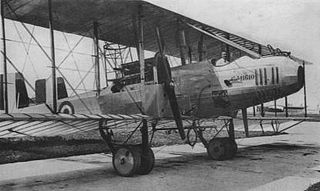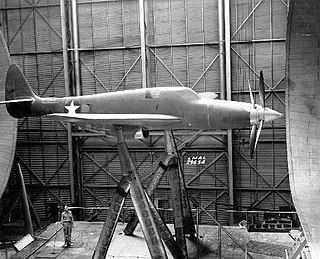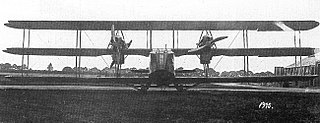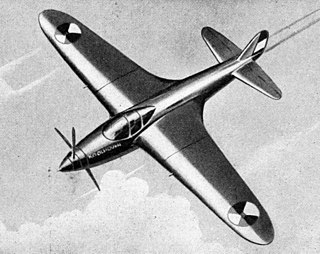Related Research Articles

The Caproni Ca.5 was an Italian heavy bomber of World War I and the postwar era. It was the final version of the series of aircraft that began with the Caproni Ca.1 in 1914.

The Republic XP-69 was an American fighter aircraft proposed by Republic Aviation in 1941 in response to a requirement by the United States Army Air Corps for a high-speed fighter. Manufacturers were encouraged to consider unorthodox designs; although the design was ordered as a prototype it was canceled because of delays with the engine that was to power it.

The Bristol Braemar was a British heavy bomber aircraft developed at the end of the First World War for the Royal Air Force. Only two prototypes were constructed.
The Potez XV was a French single-engine, two-seat observation biplane designed as a private venture by Louis Coroller and built by Potez and under licence in Poland.

The Koolhoven F.K.55 was a Dutch fighter prototype of the 1930s, which did not progress beyond the prototype stage.

The Farman NC.470 was a French twin-engined floatplane designed as a crew trainer for the French Navy. It was used in small numbers for both its intended role as a trainer and as a coastal reconnaissance aircraft at the start of World War II.

The Morane-Saulnier M.S.325 was a French Air Force fighter aircraft built by Morane-Saulnier in 1933 to meet the requirements of 1930 fighter aircraft specification. The design was unsuccessful and was abandoned in 1934.
The Farman F.130 was a 1920s French biplane designed by Farman as a long-range day bomber.

The Farman F.110 was a French two-seat artillery observation biplane designed and built by the Farman Aviation Works.

The Caproni Vizzola F.6 was a World War II-era Italian fighter aircraft built by Caproni. It was a single-seat, low-wing cantilever monoplane with retractable landing gear. Only two prototypes were built, one designated F.6M and the other designated F.6Z.

The Farman F.211 was a French four-seat day or night bomber designed and built by the Farman Aviation Works for the French Air Force.
The Farman F.270 was a prototype French bomber/torpedo-bomber designed and built by the Farman Aviation Works for the French Air Force.

The Tebaldi-Zari was an Italian fighter prototype of 1919. The Breda company later acquired the rights to it.

The Nieuport-Delage NiD 120 series was a series of French single-seat parasol monoplane fighter aircraft of the 1930s. It was built in a number of versions, fitted with various types of engines, with six aircraft designated NiD 123 being sold to Peru.
The Farman F.30A C2 was a two-seat biplane designed as a fighter in France in 1916 and powered by a single, water-cooled radial engine. It showed poor flight characteristics and only one was built, though it was modified twice. It should not be confused with the similarly named Henry Farman HF.30 of 1915, a completely different aircraft which was used in large numbers by the Imperial Russian Air Service.

The Loire-Nieuport 161 was a single-seat, single-engine, all-metal, low-wing monoplane fighter designed and built in France in 1935 to compete for a government contract. Accidents delayed its development and only three prototypes were completed.
The Wibault 9 or Wib 9 was a single seat, parasol wing fighter aircraft designed and built in France in the 1920s. It was a re-engined version of the relatively successful Wib 7, but failed to reach production.

The Wibault 12 Sirocco or Wib 12 Sirocco was a two-seat, parasol wing fighter aircraft designed and built in France in the 1920s. Three fighter prototypes were completed, one for the RAF and two Army co-operation variants. There was no series production.
The SPAD S.XV was a single-seat fighter designed and built in France and offered to fulfil a 1918 C1 specification.
The Hanriot H.33 was a French biplane 2-seat fighter aircraft built in 1926, derived from the Hanriot H.31. It was not successful and only one prototype was completed.
References
- ↑ Green, William; Gordon Swanborough. The Complete Book of Fighters. Godalming, UK: Salamander Books. pp. 201–202.